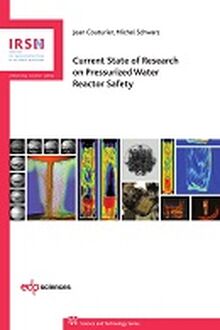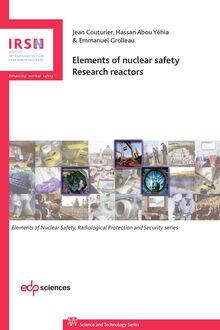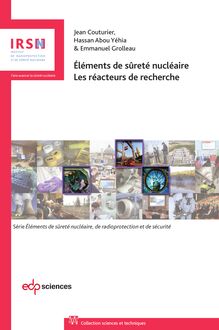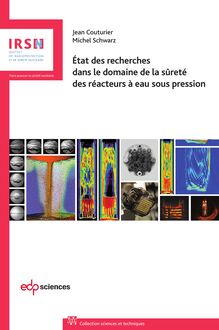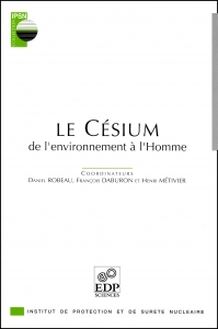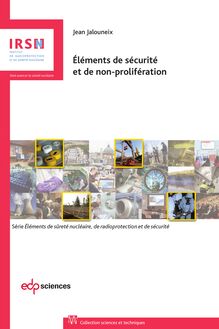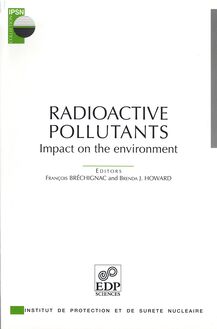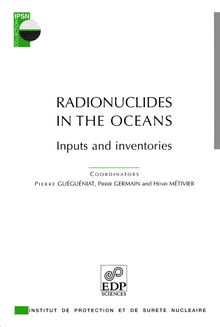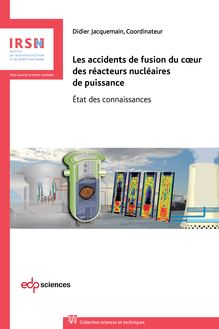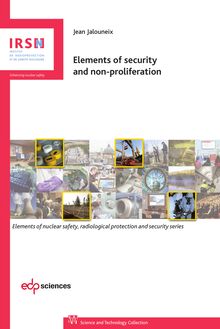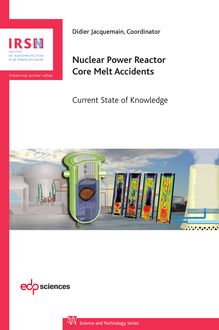Elements of nuclear safety , livre ebook
221
pages
English
Ebooks
2019
Vous pourrez modifier la taille du texte de cet ouvrage
Obtenez un accès à la bibliothèque pour le consulter en ligne En savoir plus
Découvre YouScribe en t'inscrivant gratuitement
Découvre YouScribe en t'inscrivant gratuitement
221
pages
English
Ebooks
2019
Vous pourrez modifier la taille du texte de cet ouvrage
Obtenez un accès à la bibliothèque pour le consulter en ligne En savoir plus
Publié par
Date de parution
12 novembre 2019
Nombre de lectures
0
EAN13
9782759823574
Langue
English
This publication gives a global overview of the diversity and complementarity of research reactors, some of which have been or are still being used to conduct experiments that are essential for the development and operation of nuclear power reactors, including in relation to safety issues. This work highlights the many uses of these reactors, which have very different designs, use highly varied quantities of radioactive substances with varying levels of risk for safety and radiation protection, and which — in many cases because they are old or have been shut down — require appropriate measures to control the ageing or obsolescence
of some of their equipment, as well as, on an organisational and human level, to ensure that they continue to be operated safely. For some research reactors, safety and radiation protection aspects must be considered, taking into account that two types of operators are present at the same time within these reactors: reactor operating personnel and operators in charge of experimental devices using neutrons from the reactor for fundamental or applied research purposes. There are two specific chapters on the safety standards established under the aegis of the IAEA for research reactors and on serious accidents, notably those involving criticality and reactivity, in research reactors. The second part of the work focuses on French research reactors, including the regulations and official documents applicable to these reactors, on lessons learned in France from significant events and accidents — as well as abroad, such as the Fukushima Daiichi nuclear power plant accident in 2011 — on the consideration of reactivity accidents in the design of French research reactors, and on the ten-yearly safety reviews carried out in France.
Publié par
Date de parution
12 novembre 2019
Nombre de lectures
0
EAN13
9782759823574
Langue
English
Elements of nuclear safety – Research reactors
Jean Couturier and Hassan Abou Yéhia with the help of Emmanuel Grolleau and contributors to the IRSN’s Nuclear Safety Pole
Cover image: mosaics of photographs related to the subjects dealt with the different volumes of the Elements of nuclear safety, radiological protection and security series. Highlighted, outlined in purple, are those illustrating the themes developed in this second volume of the series.
Printed in France ISBN (print) : 978-2-7598-2356-7 – ISBN (ebook): 978-2-7598-2357-4
DOI : 10.1051/978-2-7598-2356-7
All rights relative to translation, adaptation and reproduction by any means whatsoever are reserved, worldwide. In accordance with the terms of paragraphs 2 and 3 of Article 41 of the French Act dated March 11, 1957, “copies or reproductions reserved strictly for private use and not intended for collective use” and, on the other hand, analyses and short quotations for example or illustrative purposes, are allowed. Otherwise, “any representation or reproduction - whether in full or in part – without the consent of the author or of his successors or assigns, is unlawful” (Article 40, paragraph 1). Any representation or reproduction, by any means whatsoever, will therefore be deemed an infringement of copyright punishable under Articles 425 and following of the French Penal Code.
© IRSN 2019
Preface
As part of IRSN 's Science and Technology Series , the aim of the new “Elements of nuclear safety, radiological protection and security” series is, like the 1996 publication entitled Elements of nuclear safety by Jacques Libmann, to provide all those whose work involves ionizing radiation, primarily in the nuclear industry, with information regarding the technological culture relative to prevention and management of the related risks. This new series is the result of the desire not only to update the 1996 publication, but also to extend its scope to areas previously not covered or only touched upon.
In its collection of scientific works, IRSN promotes the most advanced knowledge acquired either within the Institute or in the context of national or international collaborations, focusing particularly on the educational value of its presentation. With this in mind, the specifications for this new series include clear explanations through recounting the history of developments in techniques, ideas, approaches, organizations and regulations, or through questions raised and lessons learned from accidents and operating feedback in general.
The series also aims to provide access for all those interested in these issues to technical knowledge and information that has been properly established and that can be checked in the subject areas referred to, thereby applying IRSN ’s three core values, Knowledge, Independence and Accessibility, as defined in its Code of Ethics and Professional Conduct.
We hope that this “Elements of nuclear safety, radiological protection and security” series, coordinated by Jean Couturier, will contribute to disseminating knowledge, especially as a new generation of nuclear scientists and technicians takes over from the old.
* * *
The first part of this publication gives a broad international overview of the diversity and complementarity of research reactors. It describes the many uses of these reactors, not least their significant contribution to research for power reactors’ industrial development and safety – whether related to the development of more efficient fuels or the study of the types of accident affecting these reactors –, and it discusses some safety issues specific to research reactors. Although the objectives, principles and safety (and radiological protection) approaches adopted for the design and operation of research reactors are similar to those developed over time and used for power reactors, research reactors are very diverse in terms of design and use very varied quantities of radioactive material. Some of them are operationally flexible enough to be used for a wide variety of experiments, with experimental devices that pose varying levels of risk (from the irradiation of inert materials in a capsule to tests of nuclear fuel melt in a loop, in liquid sodium, in pressurized water, etc.).
In addition, many of the research reactors around the world are old and have been through periods of temporary shutdown. Appropriate measures are necessary to manage the ageing and obsolescence of some of their components and, on an organizational and human level, to keep them operating safely. There are also different types of operators involved either in the operation of these reactors or their use; this can have an impact on safety and radiological protection, and therefore also needs to be taken into consideration.
Two specific chapters are devoted to the safety standards established under the aegis of the IAEA for research reactors and to criticality and reactivity accidents at research reactors.
These safety and radiological protection issues are discussed in more detail and illustrated in the case of French research reactors, in the second part of the publication. There are also specific chapters on the French regulatory system and the official texts applicable to these reactors, on experience feedback from significant events and accidents — including the Fukushima Daiichi nuclear power plant accident in 2011 —, on the account taken of reactivity accidents in the design of French research reactors, and on the ten-yearly safety reviews carried out in France.
I would particularly like to thank Jean Couturier, the coordinator and main editor of this publication with Hassan Abou Yéhia, for this important – and unparalleled – synthesis of the subject, as well as Emmanuel Grolleau and everyone else who gave their valuable support.
Jean-Christophe Niel IRSN Director-General
Main contributors
Jean COUTURIER has worked for the office of IRSN ’s Director General since 2012, supporting the roll-out of a knowledge management programme. He is also a senior expert in safety policy and risk analysis. He began his career working for Novatome on the design of fast neutron reactors, in the areas of fuel and safety analysis. He joined IPSN in 1986 to assess the safety aspects of the PHENIX and SUPERPHENIX fast neutron reactors. His activities then broadened to the nuclear safety of research reactors and pressurized water reactors. From 2003 to 2005 he was Strategic Programme Director for Generation IV systems. He is a member of the standing group of experts for nuclear reactors.
Hassan ABOU YEHIA retired from IRSN in 2017. Having completed a doctorate in physical sciences, from 1980 he held various technical and managerial posts at the CEA followed by IPSN and IRSN , including safety assessment for different types of nuclear facilities in France ‒ and throughout the world as part of assignments for the IAEA . From 2006 to 2012 he was responsible for the IAEA’s Research Reactor Safety Section (which also covers nuclear fuel cycle facilities). Until the end of 2016 he coordinated IRSN ’s nuclear safety training activities and participated in the training courses organized by the European Nuclear Safety Training & Tutoring Institute ( ENSTTI ).
Emmanuel GROLLEAU, has been, since the middle of 2018, assistant head of the service responsible for confinement and aerodispersion of polluants. Previously, he spent several years within the criticality studies and computation service at SGN, part of the AREVA group. He joined IRSN in 2004 to work for the assessment service responsible for research reactor safety. In particular, he directed a number of assessments on which presentations were given to the Advisory Committee for Nuclear Reactors. From 2007 to 2011 he worked for IRSN ’s Strategy and Partnerships Department. From 2012 to the middle of 2018, he has been assistant head of the service responsible for conducting safety assessments of research-related facilities and reactors undergoing dismantling within IRSN ’s Nuclear Safety Expertise Directorate.
List of abbreviations
Glossary of institutions
AFCEN : French association producing rules for the design, construction and in-service inspection of nuclear power plant components
AISI : American Iron and Steel Institute
ANCCLI: French national association of local information commissions
ANL : Argonne National Laboratory, USA
AREVA : French nuclear designer and operator (which subsequently became Orano and Framatome)
ARILL: Institut Laue–Langevin Retirees Association
ASME : American Society of Mechanical Engineers (ASME is often used to refer to the design and construction rules drawn up by this American society and used by nuclear reactor designers [Westinghouse, etc.])
ASN : Autorité de sûreté nucléaire (French nuclear safety authority)
AVN: Association Vinçotte-Nucléaire, Belgium
CEA : Commissariat à l’énergie atomique et aux énergies alternatives (Alternative Energies and Atomic Energy Commission), France
CERCA: Compagnie pour l’étude et la réalisation de combustibles atomiques (nuclear fuel design and manufacturing company), France
CI: Information commission
CIS: Internal security committee
CLI: Local information commission
CNRS : Centre national de la recherche scientifique (National Centre for Scientific Research), France
CSIA: Commission de sûreté des installations atomiques (nuclear facility safety commission), France
DAE: Department of Atomic Energy, India
DEP: Nuclear Pressure Equipment Department, ASN
DOE : Department of Energy, USA
DSN: Nuclear Safety Department, CEA
DSND: representative in charge of nuclear safety and radiological protection for French defence-related activities and facilities
EDF : Electricité de France (French power utility)
ENSREG : European Nuclear Safety Regulators Group (a European Commission consultative group of independent experts)
FzK: Forschungszentrum Karlsruhe (Karlsruhe Institute of Technology, Germany)
